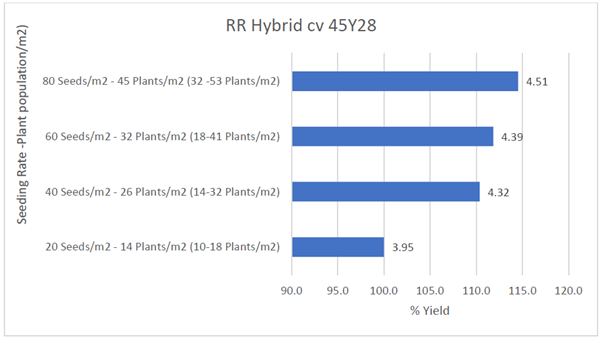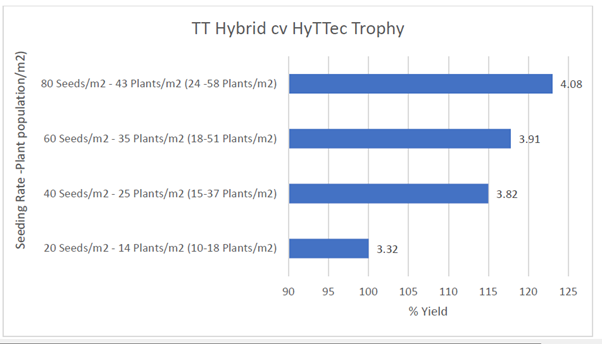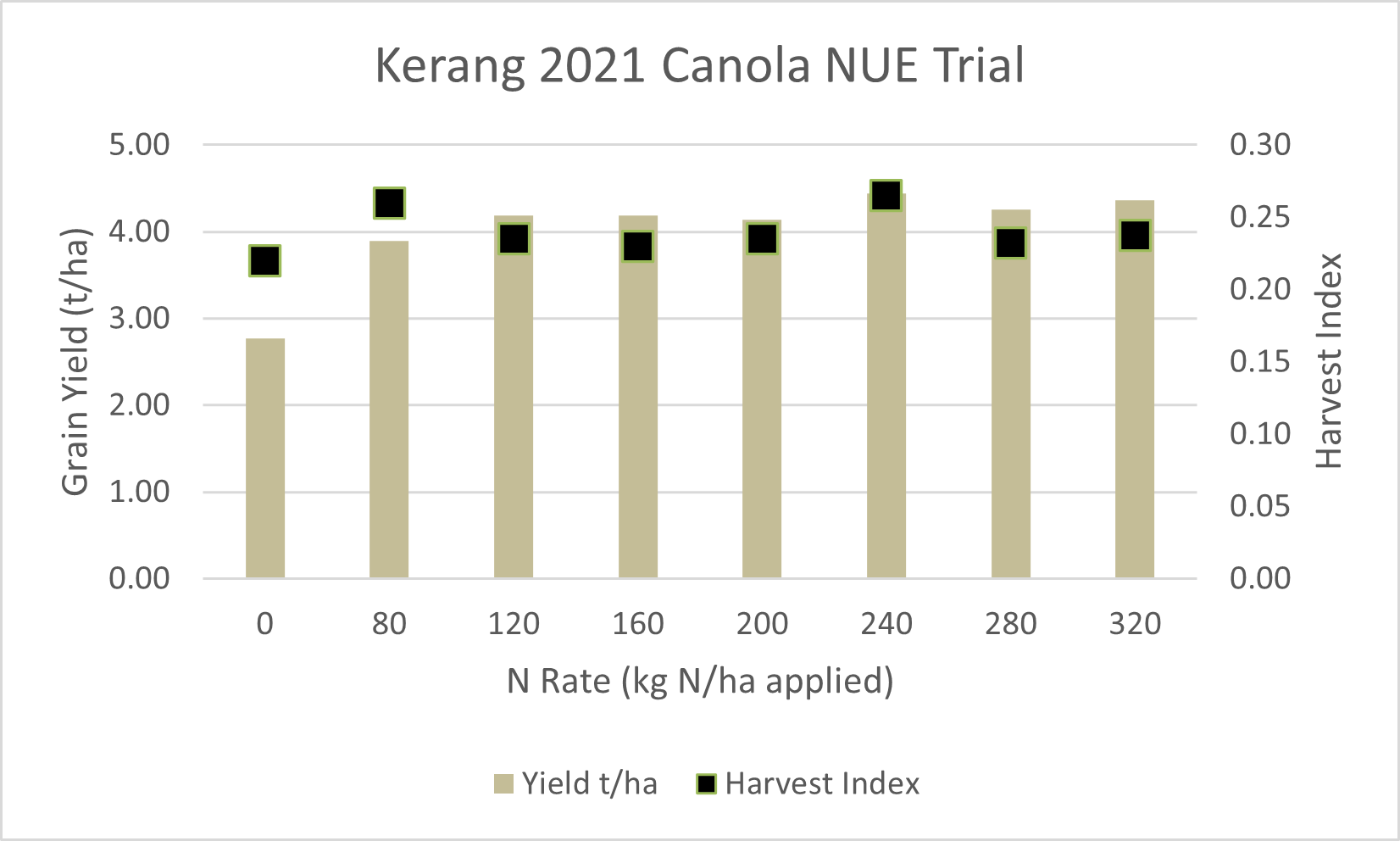Irrigated canola agronomy – revisited, reviewed and revised
Author: Damian Jones (Irrigated Cropping Council) | Date: 14 Jul 2022
Take home messages
- High yields come from fertile paddocks, not fertiliser.
- Establishment of 40 plants/m2 sets up the crop to maximise yield.
- Nitrogen budgeting is essential to ensure the target yield can be met.
- Timing of N application is flexible.
Background
The following paper is a summary of the first two years of results from the canola research of the Optimising Irrigated Grains (OIG) project and draws on the summary document published by FAR Australia. Canola is one part of the OIG project — the focus being to identify the agronomic and amelioration levers for maize, chickpeas, faba beans, canola, barley and durum wheat. The project is co-ordinated by FAR Australia, with the Irrigated Cropping Council being a key research partner. The research project dovetails into two other GRDC supported irrigation projects, the Irrigated Discussion Groups (managed by the Irrigated Cropping Council and the various irrigated Farming System Groups in South-eastern Australia) and the University of Tasmania’s economics project.
Method
The trial program to identify the key agronomic principles for growing irrigated canola started in the 2020 season. The research sites are at Finley, NSW and Kerang, Victoria. Both sites have surface and overhead irrigation (the Kerang site is predominantly surface irrigation) and have a number of trials that are examining sowing rates; nitrogen rates and timing; irrigation; and disease management. Many trials are replicated at both sites, while some are at one site only, for example, disease management at Finley.
Results and discussion
Establishment
Target a plant population of approximately 40 plants/m2
Getting the establishment right is the first step in ensuring a high yielding crop. Under irrigated conditions, small differences in plant population have a “magnifying” effect in terms of yield. Where plant populations have fallen below the optimum, there have been substantial yield penalties, whilst having too many plants has seen little response in yield. The trials have involved seeding rates ranging from 20 to 80 seeds/m2. This has corresponded to seeding rates in 2021 of 1.1 to 4.8kg/ha, which is, of course, dependent on seed size. As an example, our 2022 variety trial sowing rate varies between 1.9 and 4.0kg/ha. It is deliberate to use the terms seeding and sowing rates to reflect the actual practices — in the trial, we put out x number of seeds/m2 and count how many plants we achieve, while when sowing a paddock, we are sowing at a rate that will deliver a certain number of plants/m2. From our years at the ICC Trial Block, the proportion of seeds that actually form plants is approximately 70% when watering up and so, our sowing rate accounts for this loss. Your experience will tell you what your establishment rate is based on your emergence counts.
Plant populations in the 10–15 plants/m2 range have seen very large losses of yield and thus, income. Where populations have been in the 25–30 plants/m2 range, we have seen enough compensation to remove much of this yield penalty, but productivity and profitability has been increased further with populations at 40–50 plants/m2, despite the additional cost of seed.
Influence of hybrid RR vs. TT
Higher yields under irrigation magnify differences relative to dryland. The Roundup Ready hybrid 45Y28 has been consistently higher yielding than the hybrid TT HyTTec. A mean 17% advantage (range 15–18%, mean 0.64t/ha) has been observed at Finley Irrigated Research Centre worth $448/ha at $700/t. At Kerang, the difference hasn’t been as great and was approximately half that observed at Finley (9%, 0.33t/ha) worth $231/ha.
Looking at a broader range of varieties at the ICC Trial Block, on average RR yield is 12% higher than the TT’s (Figures 1 and 2).

Figure 1. Influence of plant population on seed yield (t/ha) using the RR hybrid 45Y28 in six irrigated
trials conducted at Finley and Kerang, in 2020 and 2021.

Figure 2. Influence of plant population on seed yield (t/ha) using the TT hybrid HyTTec Trophy in six irrigated trials conducted at Finley and Kerang, in 2020 and 2021.
Nitrogen management
NUE may be better under irrigation
Growing 5t/ha canola crops under irrigation does not require very large quantities of artificial nitrogen, it requires a fertile farming system that enables large crop canopies to draw down from a high soil N reserve in order to satisfy crop demand.
The highest yielding irrigated canola crops in the project have been produced in paddocks where inherent fertility is high, with applied artificial N rates typically no more than 160–240kg N/ha at Finley and 80–120kg N/ha at Kerang.
These fertile irrigated paddocks can often produce reasonable crops with little or no artificial N as soil N mineralisation provides a greater proportion of the N supply, for example, Finley and Kerang 2020 yields were in excess of 3t/ha, achieved with only MAP at sowing.
Looking specifically at the Kerang results, calculating the Nitrogen Use Efficiency of trial yields exceeding 4t/ha reveals a NUE of approximately 60kg N/t. This is roughly 75% of what is considered the accepted standard of 80kg N/t and most likely reflects the ability of an irrigated crop to draw on N from the soil for the entire growing season, in contrast to dryland crops that may start to suffer moisture stress during grain fill in most seasons.
Canola yields at Kerang in 2020 were 3.00–3.63t/ha based on 0–320kg N/ha applied, with an optimum of 80kg N/ha. In 2021, from the same N range, the canola yields were 2.74–4.36t/ha, with an optimum of 120kg N/ha (Figure 3). In Finley during 2020, yields were 3.91–4.71t/ha, with an optimum of 160–200kg N/ha, and in 2021, 2.21–4.22t/ha, with an optimum of 240kg N/ha.

Figure 3. Influence of nitrogen rate on seed yield (t/ha) and harvest index using the RR hybrid 45Y28in the 2021 irrigated trial conducted at Kerang.
Harvest index was not influenced by N rate — dry matter production followed a similar trend to yield in that DM plateaued at 120kg N/ha at approximately 16.5t/ha.
Timing of N application is flexible
In the trials conducted so far, there have been few, if any, differences in seed yield due to N timing, with N rate being the most important. Timings of pre-sowing, 6-leaf, green bud and yellow bud using split applications have made little difference to yield or oil content so far (Figure 4).
Figure 4. Influence of nitrogen rate and timing on seed yield (t/ha) and oil content (%) using the RR hybrid 45Y28in the 2021 irrigated trial conducted at Kerang.
Disease management
Little response to fungicide application to date
In the OIG project trials at Finley in 2020 and 2021, the maximum responses to disease management strategies have been relatively small (0.13t/ha and 0.28t/ha, respectively) in irrigated canola crops of ATR Bonito.
The research work conducted on canola has been subject to upper canopy blackleg and crown canker but not sclerotinia.
In these cases, flutriafol applied in-furrow followed by Miravis® at 4–6-leaf has been one of the most effective treatments, although the yield increases have been small and only statistically significant in 2021.
Fungicide trials have not been conducted at Kerang due to limitations to the number of trials possible and previous work showing little response.
Plant Growth Regulators – controlling crop height and lodging
Response to PGRs but temporary
The OIG project work has been conducted by the FAR Australia team at Finley. Experimental PGR applications (based on gibberellin inhibitors) have been successfully employed to reduce crop height in irrigated canola, however the effects of the PGR, which manifested at flowering, have largely worn off by harvest. So far, these transient reductions in crop height have not been associated with any improvement in seed yield.
Previous work undertaken by the ICC saw similar results. Statistically significant but practically irrelevant reductions in crop height of approximately 100mm could be achieved, but with little influence on crop yield or lodging reduction. Selecting the correct variety, sowing rate/population and managing N should negate the need for a PGR.
Conclusion
- Paddock fertility drives high yielding crops, not artificial fertilisers.
- Target a plant population of approximately 40 plants/m2.
- Match the N applied to target canola yield and subsequent N requirement given the soil may be able to supply much of the N already.
- There is flexibility in the timing of N application in irrigated canola.
Acknowledgements
The research undertaken as part of this project is made possible by the significant contributions of growers through both trial cooperation and the support of the GRDC, the author would like to thank them for their continued support. The author thanks FAR Australia for preparing the interim ‘Key Learnings’ summarising the OIG canola trials conducted in 2020 and 2021
Useful resources
GRDC website for various OIG videos and podcasts
Contact details
Damian Jones
Irrigated Cropping Council
PO Box 549, Kerang VIC 3579
0409 181 099
damian.jones@irrigatedcroppingcouncil.com.au
GRDC Project Code: FAR1906-003RTX,
Was this page helpful?
YOUR FEEDBACK
